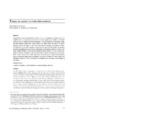‘Línguas em contacto’ na Galiza Baixo-medieval

Ver/
Use este enlace para citar
http://hdl.handle.net/2183/2605Coleccións
Metadatos
Mostrar o rexistro completo do ítemTítulo
‘Línguas em contacto’ na Galiza Baixo-medievalAutor(es)
Data
2004Cita bibliográfica
Revista Galega de Filoloxía, 2004, 5: 33-50. ISSN 1576-2661
Resumo
[Resumo] O principal elemento legitimador dos estados nacionais é actualmente a língua, como foi a
religião outrora. A língua tem na nossa época o mesmo papel que a religião na sociedade
medieval: é um elemento basilar na legitimação e no funcionamento da instituição estatal.
Há uma diferença radical num ponto concreto: na Idade Média não parece ter havido
rejeição à mistura de línguas, o que é uma característica constante nas modernas sociedades
industriais. Neste artigo estudam-se alguns factores que terão dificultado a substituição
do galego-português pelo castelhano na elaboração dos documentos jurídicos na Galiza dos
finais da Idade Média: (i) o peso de uma tradição de vários séculos, e (ii), ser o galego-português
a língua da oralidade e a mais inteligível para as partes intervinientes nos actos jurídicos.
Desde o século XIII Castela representa o centro do poder, e há um relacionamento
intenso da nobreza galega com a castelhana. Nos finais do século XV muitos nobres são
obrigados a residir na Corte. Nessa época o castelhano já era percebido como a língua da
autoridade. [Abstract] Just like religion before it, language in our day has become the principal legitimising element
for national states. Today, language plays the same role as religion did in medieval
society: it constitutes a basic element in the legitimisation and functioning of the state as an
institution. Yet there is a radical difference in one aspect: during the Middle Ages there does
not appear to have been a sense of rejection of the mixing of languages, which is, however,
a constant feature of modern industrialised societies. This article looks at a number of factors
which have led to difficulties in replacing Galician-Portuguese for Castilian Spanish in
legal documents in the late Middle Ages: (i) the weigth of a tradition dating back several
centuries and (ii) the fact that Galician-Portuguese was used for oral communication and
was therefore the most intelligible language for all those parties intervening in legal procedures. Since the 13th century many members of the aristocracy were forced to reside in Court.
By this time Castilian Spanish was already held to be language of “authority”.
Palabras chave
Contacto de línguas
Conflito lingüístico
Galego-portugués medieval
Contact between languages
Linguistic conflict
Medieval galician-Portuguese
Conflito lingüístico
Galego-portugués medieval
Contact between languages
Linguistic conflict
Medieval galician-Portuguese
ISSN
1576-2661





